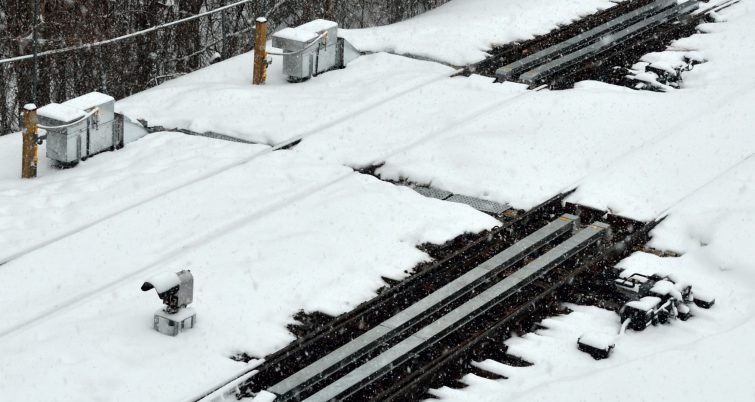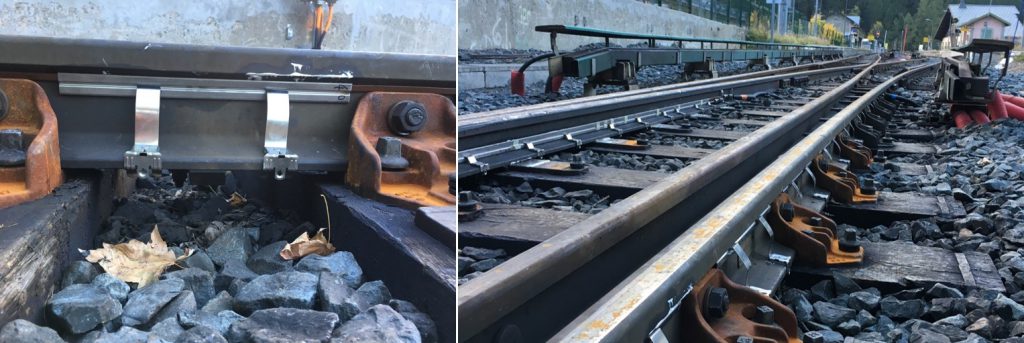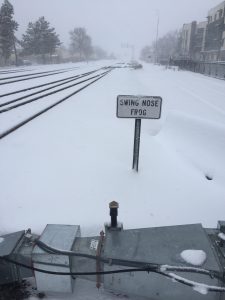Winter maintenance: Fighting the cold
Written by Kyra Senese, Managing Editor
Suppliers and transit agencies continue their efforts to keep safety at top-of-mind while considering machinery requirements during winter maintenance.
Severe winter storms and extreme cold snaps are an inevitable challenge year after year, but suppliers and transit systems remain vigilant in their efforts to focus on safety, productivity and reliability.
This year, RT&S checks in with NJ Transit and railroad industry suppliers on their efforts to combat harsh winter conditions that can erode safety along the rails.
NJ Transit
As with all railroads across the country, the fall and winter seasons present challenges to NJ Transit. As leaves drop onto tracks, they are crushed under the rails, producing an oily substance that coats the rails and causes poor traction.
NJ Transit said it uses two AquaTrack machines to clean and remove the leaves from the rails to prevent “slippery rail’’ conditions throughout the fall season. Additionally, branches that have fallen and are caught in the catenary also impact service and create delays. NJ Transit has a year-round preventative maintenance program during which the agency inspects tree growth and trim branches that hang too closely to the catenary and right-of-way, the transit system said.
As with recent years, NJ Transit said the agency prepares by winterizing hundreds of rail cars and locomotives.
“This process includes checking onboard heating systems, ventilation, thermostats, weather stripping and electronic components,” the transit system said. “Additionally, NJ Transit maintenance forces stockpile stone, while inspecting culverts, drainage pipes and rights-of-way to ensure they are clear of blockages that could exacerbate flooding and disrupt service.“
NJ Transit’s preventative maintenance program also entails the inspection and winter maintenance of more than 750 switches and switch heaters, overhead wire systems, a dozen moveable bridges and wayside power at storage yards and terminals, officials said.
During or following a storm, the agency has two jet-engine-powered snow blowers available to remove ice and snow from tracks and critical switching areas. All locomotives are equipped with snow plows to clear snow from the rails.
“Our year-round tree trimming program proactively minimized downed trees or limbs along the right-of-way and on our overhead electric system,” NJ Transit explained, “Personnel are on standby to quickly respond to reports of trees or limbs that could damage overhead wires or prevent the safe passage of trees.”
In addition, NJ Transit said its Emergency Operations Center (EOC), coordinated by the New Jersey Transit Police Department Office of Emergency Management (OEM) may be opened to monitor conditions statewide when needed. The EOC allows the transit system to quickly share and disseminate information to respond to potential service impacts.
As with any emergent situation, crews can also be impacted by winter weather storms. NJ Transit said the agency monitors the weather along with its OEM from the police department.
“When storms or bad weather such as heavy rain, high winds, and coast storm surges are coming, we do assign staff from mechanical and infrastructure in strategic locations to protect our service,” NJ Transit said. “If weather conditions warrant it, we activate our EOC along with the state and local municipalities to protect our service. In cases of extreme weather, we may activate our CEMP process to temporarily suspend service to our crews, infrastructure and equipment.
NJ Transit said jet-engine powered snow blowers are particularly helpful in efforts to clear critical switches.
Suppliers weigh in
While transit systems like NJ Transit are winterizing rail cars and managing their crews, suppliers throughout the U.S. have been modifying their offerings to better support the railroads. Heating solutions, snow and ice removal equipment and detectors are just a few options on the market that can help winter transit rides smoother and safer.
nVent
nVent offers a full line of rail infrastructure heating solutions intended to help railways operate safely and efficiently in harsh winter conditions. nVent provides systems for heating switches, third rail (contact rail) and catenary (overhead) wires, from its product portfolio, including heating technology from nVent RAYCHEM, and cable-to-rail fastening solutions from nVent ERICO, a rail industry supplier for more than 100 years.
nVent supplies switch heating systems with self-regulating heating cables, providing a solution that aims to deliver robust heat for melting snow and ice on track switches that is also energy efficient, the company said. Self-regulating heating cables work by automatically adjusting their power output to compensate for rail temperature changes, allowing the cable can feel the rail temperature, automatically releasing heat only when it is needed, and varying heat output along the length of the cable based on rail temperature variations.

The nVent Self-Regulating Switch Heating System is a solution intended to keep turnouts free from snow and ice build-up.
Self-regulating heating cable technology is based on a conductive polymer core that reacts to rail temperature drops by contracting, increasing the number of heat delivering electrical paths. Conversely, nVent explained that the conductive core expands as temperatures raise, cutting down on the number of electrical paths to restrict heat output.
“Because the reaction is happening in the cable itself, nVent self-regulating switch heating solutions do not require a complex underlying systems,” the company said.
The nVent switch heating product line provides numerous control options that are meant to easily integrate into existing infrastructure and make operations simple.
“You can virtually set it and forget it knowing that it will automatically begin releasing heat when temperatures drop,” nVent explained. “Because it only is operating when it needs to, self-regulating switch heating systems eliminate wasted energy consumption, making it up to 30 percent more efficient than conventional tubular heaters.”
Rails Company
Rails Company offers a complete line of snow removal equipment, including five types of switch heaters, snow detectors, automatic control systems, including a new wireless control and monitoring system and accessories.
“There is a Rails Switch Heater for every requirement; all available for dispatcher control or automatic operation,” the company said.
In addition to HAB Hot Air Blower Switch Heaters, the company offers Tublar Electric Switch Heaters that it said can be controlled and monitored by the Rails Wireless Remote Control Systems.
The Rails Co. High/Low Hot Air Blower Switch Heater also now uses a more powerful 5 hp high-pressure blower to distribute high velocity, high volume hot air throughout the switch area via ducts and nozzles, keeping the switch open and operative in severe winter weather.
The unit delivers 3600 cfm of hot air to the switch area, which the company said is more than double the volume of previous models. It is equipped with a user-adjustable High/Low BTU output which minimizes fuel usage, and a variable, timer-based Hi/Lo flame control is also provided that is adjustable to each application.
The 5hp High/Low HAB Switch Heaters can be fueled by natural gas or propane. The company said its simple design and control package—there are no proprietary printed circuit board controls as all control components are off-the-shelf—assures high reliability and lower service costs. They provide the power to protect single or multi-track operations and are adaptable to switches with or without covers installed.
Units can be operated automatically by a snow detector, dispatcher or manual method. When combined with Rails’ Wireless 900MHz Radio Control System, a wireless communication network, the company said units provide wireless control and monitoring of the heaters.
“Wireless controls eliminate control wires buried in the ground in new or existing installations,” Rails Co. said. “Switch heaters may be started or stopped and running status monitored from a local bungalow or control room or remotely. When the heaters are initiated, the system performs a status check to assure that it is working properly.”
For remote control and monitoring, the company said its system can be integrated with a controller and secure VPN router to provide remote control and monitoring via the internet. The secure network can be connected and accessed with a personal computer, mobile phone or tablet.
Railway Equipment Company
Winter weather has the ability to drastically reduce train velocity. From frozen switches, to hot box detectors that are not reporting, to the dangers involved in personnel traveling during winter events, Joe Ashley, VP & general manager, says the network can come under a tremendous strain if a railroad is not prepared for these harsh conditions. Ashley notes the importance of preparation during these extreme weather events.
“In our case, that means the railroad ensures they have the best, most reliable equipment in any and all locations that could have a significant impact on their ability to service their shippers,” Ashley said. “The reliability of our switch heaters combined with enhanced remote visibility of how they are operating continues to reduce our customers’ exposure to winter events.”
He said the challenge faced during the cold months is twofold. First and foremost, he said it is crucial to ensure the company can supply its customers with the right equipment in a timely fashion. The company also works hard to keep its internal technical support staff available around the clock to help with any trouble-shooting that may be needed to keep the trains rolling, he explained.
“Every year across North America, railroads face insurmountable odds to keep trains running when the worst weather hits,” Ashley said. “Be it multiple feet of snow falling in the mountains to high winds causing what could be impassable drifts, if not for the tenacity of the railroads and the equipment supplied to them.”
During a particularly bad winter event, he said the company often sees needs from its customers to get products in their hands immediately. For the most part, Ashley said railroaders in tough winter environments are very good at preparing for the winter by ordering the necessary equipment ahead of time. To date, the winter of 2018-2019 has been quite unique, he said.

A fully functioning high-speed switch from Railway Equipment Company keeps things moving in Minneapolis during one of the worst recent snow storms in the area.
“As I look out my window in in Minneapolis, I only see a small dusting of snow on the ground. Winter weather has hit areas of the country so far this year that typically aren’t as expecting of it,” he explained. “My crystal ball suggests that any drops in velocity due to this irregular weather pattern will result in better preparation in these areas going forward.”
Thermon Heating Systems
Although weather forecasts provide warning of extreme weather, Gregor Harris, business development manager-Rail for Thermon Heating Systems, said aspects of this weather such as drifting snow, plowed and dragged in snow, blocks of snow and extreme cold conditions pose particularly difficult challenges.
“In the days and weeks after a snowfall, wind-blown snow creates ground level snowstorms,” Harris explained of drifting snow. “When these cross a switch, snow settles on the leeward side of the rails, or packs in between the stock rail and the points, which eventual interferes with the switch operation.”
Plowed and dragged-in snow and can be problematic as trains passing through large a accumulation of snow on the tracks will plow and drag snow into the points. Harris explained that blocks of snow and ice interfering with the points allow for snow to build up on rail cars passing through the storms, which then fall into the switch points later. This can occur a day or two later, and in an area not directly affected by the storm, he notes.
When snow is accompanied by extreme cold weather, undersized heating systems can create icing conditions that lead to frozen points, switch rods and restricting proper ballast drainage, Harris said.
He added that when the company initially began supplying Snow Clearing Devices (SCDs), they were considered a nice product to have but were rarely given serious consideration.
“Railroads can no longer afford the delays associated with winter weather,” Harris explained. “Most railroads now have assigned the responsibility of preparing for winter weather to one or more departments, and winter preparedness is part of their standard operating procedures and budgets.”
Reliable and effective SCDs are, in Harris’ opinion, the best assurance of smooth winter operations.
“They have to operate during the worst winter conditions and at the same time survive the shock and vibration from year-round train traffic,” he explained.
Thermon products have been in service for decades throughout North America. Harris said the company’s designs have evolved through customer feedback and cooperation to offer a reliable, effective and efficient solution for the market.
Controls have to work at temperatures as low as -40C, he notes, while gas-fired hot air systems need to light and run reliably during snowstorms, while electric heating elements need to maximize heat transfer to the rail, he said.
SCDs need to be implemented as soon as it snow begins to fall, Harris said.
“Our systems operate automatically by detecting falling or drifting snow, and freezing rain,” he explained. “This avoids dispatch having to turn them on ahead of time, which increases energy consumption and cost. Worse yet, when dispatch fails to turn them on until it is too late, and trains delayed.”
Harris explained that it is important to use adequately sizes switch heaters to ensure they can quickly recover a switch, such as when it is necessary to clear dragged and dropped-in snow and ice from passing trains or clearing accumulated snow following a power outage.
Locations experiencing difficult-to-detect drifting snow, Harris said the company’s Hellfire gas fired blowers are configured for continuous fan operation, keeping air flowing within the switch and minimizing snow accumulation.
The company also offers its Horizontal Air Curtain systems (HACs), which Harris said are suited to extreme cold locations, where snow is dry and light. Directing high-velocity cold air at the points prevents snow from entering the switch, and HACs are used to maintain a clear line of sight for hot-bearing and wheel scanners.
Although not a typical application, Harris said the company has had a customer approached it for a solution concerning the formation of ice on the walls of a mountain tunnel.
“Ground water seeping into the tunnel continually froze and accumulated until it violated the track clearance envelope, at which point trains could no longer pass,” he explained. “After a prolonged delay, excavators arrived to clear the ice from the walls as far as 900 feet in from the entrance. Thermon supplied a pair of our Hellfire 900’s and a custom duct system and has successfully kept the tunnel clear ever since.”
He explained that many of Heating Systems’ customers understand the importance of being prepared for winter by the fall. Those who are not prepared do tend to place last-minute or post-snowstorm orders, Harris said.
“We understand this and stock our standard product offering with next-day delivery of spare parts and two-week delivery of complete systems,” he said. “After particularly bad winters, identified as the root cause of train delays and contract penalties, we often see switch heaters become a high priority and receive large orders in the spring and summer.”





